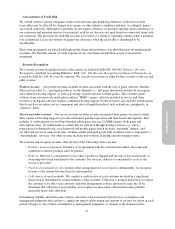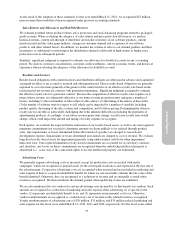Electronic Arts 2012 Annual Report Download - page 155
Download and view the complete annual report
Please find page 155 of the 2012 Electronic Arts annual report below. You can navigate through the pages in the report by either clicking on the pages listed below, or by using the keyword search tool below to find specific information within the annual report.
Annual Report
Concentration of Credit Risk
We extend credit to various companies in the retail and mass merchandising industries. Collection of trade
receivables may be affected by changes in economic or other industry conditions and may, accordingly, impact
our overall credit risk. Although we generally do not require collateral, we perform ongoing credit evaluations of
our customers and maintain reserves for potential credit losses. Invoices are aged based on contractual terms with
our customers. The provision for doubtful accounts is recorded as a charge to operating expense when a potential
loss is identified. Losses are written off against the allowance when the receivable is determined to be
uncollectible.
Short-term investments are placed with high quality financial institutions or in short-duration, investment-grade
securities. We limit the amount of credit exposure in any one financial institution or type of investment
instrument.
Revenue Recognition
We evaluate revenue recognition based on the criteria set forth in FASB ASC 985-605, Software: Revenue
Recognition, and Staff Accounting Bulletin (“SAB”) No. 101, Revenue Recognition in Financial Statements,as
revised by SAB No. 104, Revenue Recognition. We classify our revenue as either Product revenue or Service and
other revenue.
Product revenue. Our product revenue includes revenue associated with the sale of game software, whether
delivered via a disc (i.e., packaged goods) or via the Internet (i.e., full-game download) and that do not require
our continuous hosting support, as well as licensing of game software to third-parties. This excludes game
software from our massively multi-player online (“MMO”) games, which is included in service and other
revenue as such game software requires continuous hosting support. Product revenue also includes mobile games
that do not have an online service component and sales of tangible products such as hardware, peripherals, or
collectors’ items.
Service and other revenue. Our service revenue includes revenue recognized from games or related content
that requires our hosting support to provide substantial gaming experience and time-based subscriptions. This
includes (1) subscriptions for our Pogo-branded online game services (2) MMO games (both game and
subscription sales), (3) entitlements to content that are delivered through hosting services (e.g., micro-
transactions for Internet-based, social network and mobile games which includes “freemium” games), and
(4) allocated service revenue from sales of online-enable packaged goods with an online service component (i.e.,
“matchmaking” services). Our other revenue includes non-software licensing and advertising revenue.
We evaluate and recognize revenue when all four of the following criteria are met:
•Evidence of an arrangement. Evidence of an agreement with the customer that reflects the terms and
conditions to deliver products must be present.
•Delivery. Delivery is considered to occur when a product is shipped and the risk of loss and rewards of
ownership have been transferred to the customer. For services, delivery is considered to occur as the
service is provided.
•Fixed or determinable fee. If a portion of the arrangement fee is not fixed or determinable, we recognize
revenue as the amount becomes fixed or determinable.
•Collection is deemed probable. We conduct a credit review of each customer involved in a significant
transaction to determine the creditworthiness of the customer. Collection is deemed probable if we expect
the customer to be able to pay amounts under the arrangement as those amounts become due. If we
determine that collection is not probable, we recognize revenue when collection becomes probable
(generally upon cash collection).
Determining whether and when some of these criteria have been satisfied often involves assumptions and
management judgments that can have a significant impact on the timing and amount of revenue we report in each
period. Changes to any of these assumptions or management judgments, or changes to the elements in the
71
























